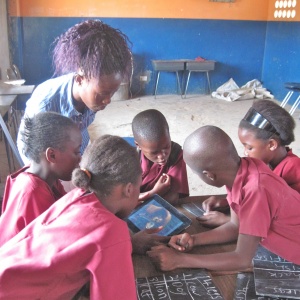OER4Schools/activities/Magic microphone
| Resource details | |
| Title | Magic microphone |
| Topic | |
| Teaching approach | |
| Learning Objectives | |
| Format / structure | |
| Subject | |
| Age of students / grade | |
| Table of contents | |
| Additional Resources/material needed | |
| Useful information | |
| Related ORBIT Wiki Resources | |
| Other (e.g. time frame) | |
| Files and resources to view and download | |
| Acknowledgement | This resource is part of the OER4Schools programme. |
| License | |
This is a useful technique to encourage students to speak out in the classroom. The teacher poses a question for the students to think about before initiating the use of a prop which is passed around the room. The prop is a tool that the students can use independently to make talk equitable. It could be any small item such as a ball or a bean bag that can be easily passed from one student to another. The student who is holding the prop has permission to speak. When they have finished speaking they then pass the 'magic microphone' on to another willing participant.
Here are the steps:
1. Students listen to a question or a discussion point and are given wait time to formulate their responses. The teacher can introduce the technique either before or after posing the question.
2. Following the wait time, the prop is passed to a student who is willing to say out loud what their response is to the question.
3. The prop (or 'magic microphone') is then passed around the room from student to student with all students who get the prop speaking their responses out loud. A student who does not wish to speak simply passes the prop on to another who does.
Tips for using the technique successfully:
- establish a friendly, supportive, non-judgemental atmosphere using positive body language and reaffirming phrases
- remind students to listen to what other students have said as they may have to adjust their response accordingly
- try to keep the activity pacy, encouraging students to quickly pass the prop between themselves
- praise students for active listening, for making a contribution and for respecting the contributions made by others
- manage the movement of the 'magic microphone' and draw together points from the talk/discussion, paraphrasing them if necessary


